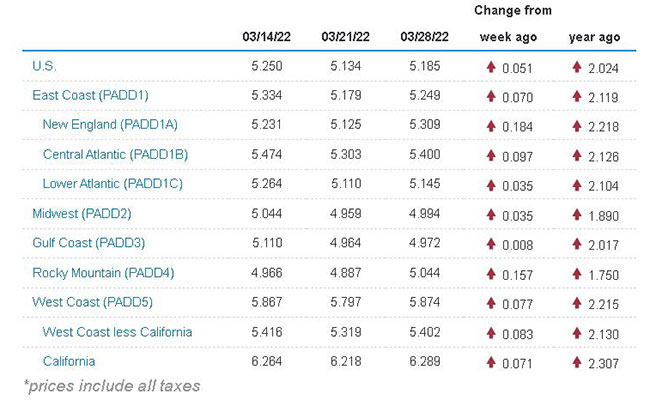Senior Reporter
Diesel Resumes Upward Trend With 5.1¢ Increase

[Stay on top of transportation news: Get TTNews in your inbox.]
The national average price for diesel resumed its upward trajectory after a one-week respite, gaining 5.1 cents to settle at $5.185 a gallon, according to Energy Information Administration data released March 28.
Diesel has gained in 11 of the past 12 weeks, the exception being an 11.6-cent decline March 21. A gallon of trucking’s main fuel now costs $2.024 more than it did at this time in 2021.
All 10 regions in EIA’s weekly survey reported increases, with the largest hike being 18.4 cents in New England. The Gulf Coast posted the smallest price gain, eight-tenths of a cent. California, which showed a 7.1-cent rise to $6.289, remains the only region in which a gallon of diesel exceeds $6.
U.S. average on-highway #diesel fuel price on March 28, 2022 was $5.185/gal, UP 5.1¢/gallon from 3/21/22, UP $2.024/gallon from year ago https://t.co/uEBq8uMFZ1 #truckers #shippers #fuelprices pic.twitter.com/NAUiqbW4hT — EIA (@EIAgov) March 29, 2022
Motorists can breathe a bit easier since the price of gasoline didn’t climb any higher; in fact it dropped by eight-tenths of a cent and sits at $4.231 a gallon.
The price of a barrel of oil is the largest factor determining the price of a gallon of fuel, either diesel or gasoline. The price of a barrel of West Texas Intermediate crude oil over the past 52 weeks climbed to $108.63, as of March 30, from $55.10.
Then, in early trade on March 31, oil prices fell on speculation that President Joe Biden is considering releasing 1 million barrels of oil a day for 180 days from the Strategic Petroleum Reserve to increase supply in the hopes of reducing fuel prices at the pump.
Crude has largely traded above $100 a barrel since Russia invaded Ukraine. Ensuing sanctions against Russia have caused extreme price gyrations in the oil market, leaving investors wary of trading. For the month of March, WTI has fluctuated on average more than $9 per session, Bloomberg News reported.
U.S. average price for regular-grade #gasoline on March 28, 2022 was $4.231/gal, DOWN 0.8¢/gallon from 3/21/22, UP $1.379/gallon from year ago https://t.co/P5ttfYLtwH #gasprices pic.twitter.com/Whzhlr5Z6S — EIA (@EIAgov) March 29, 2022
“My mind is going a mile a minute just trying to keep up with every twist and turn in this [oil] market, which has been unbelievable,” Phil Flynn, senior energy analyst at The Price Futures Group, told Transport Topics.
There is extreme volatility “from headline to headline,” Flynn said. “But I think we would have seen prices go up regardless.”
The solution, he said, to bringing down diesel prices is “a turn in attitude” within the Biden administration, with its focus on the electric future. “We are burning down the house before the new house is built. We have under-invested in oil and are seeing, week after week after week, inventory levels that continue to fall.
“It really pains me that this is happening,” Flynn said.
Moving in the midst of it all are the truck drivers needing to buy skyrocketing diesel.
One third-generation independent truck driver recently said surging fuel prices will squeeze out many small carriers, which make up the vast majority of the trucking industry.

Duran
“Only the strong are going to survive at this point,” said Jacinda Duran, also the first brand ambassador for Blackburn Energy and its RelGen product that uses power from the rotation of the drive shaft behind the transmission to replenish batteries.
“Freight prices are not going up following the fuel prices,” Duran said. “It’s rising every day, literally you see fuel prices go up 40 cents, 50 cents, 60 cents overnight. An average fuel week was about $1,500, $1,600. Now it’s $2,400 a week.”
Duran was interviewed with Convoy co-founder Grant Goodale, riding with her on his way to the Mid-America Trucking Show. She has been using Convoy’s digital freight network to secure loads since 2017.
Denver-based Vorto announced it boosted its fuel discount program for carriers using its 5F platform — intended to create more opportunities for drivers and reliable capacity for shippers and brokers — giving them an additional 15 cents a gallon on top of an earlier discount of the same amount. The discount is accepted at all Pilot Flying J Truck Stops.

Host Michael Freeze discusses the future of tire maintenance with Yokohama's Tom Clauer and Goodyear's Austin Crane and Jessica Julian. Hear a snippet above, and get the full program by going to RoadSigns.TTNews.com.
“Fuel prices have increased rapidly and as a result, small trucking fleets are losing earnings, as many don’t have access to bulk discounted fuel,” said Vorto CEO Priyesh Ranjan. “Costs like repairs and replacements are traditionally accounted for in budget planning for owner-operators. Additionally, many likely have insurance policies that can help offset the costs of those items. This abrupt spike in fuel prices is something that no driver or owner could have planned ahead for.”
Meanwhile, the Owner-Operator Independent Drivers Association, which has an online fuel surcharge calculator, noted most owner-operators use brokers, who don’t typically pay a fuel surcharge. It advised truckers to incorporate “your fuel surcharge in your all-inclusive rate negotiations.”
Petroleum and natural gas are set to remain the most-consumed sources of energy in the United States through 2050, but renewable energy is the fastest growing, EIA wrote in its Annual Energy Outlook 2022.
“We project renewable diesel supply will increase to 130,000 barrels per day in 2022 and 145,000 b/d in 2050, reflecting a significant increase in renewable diesel production capacity in the near-term,” EIA wrote.
U.S. On-Highway Diesel Fuel Prices

EIA.gov
Want more news? Listen to today's daily briefing below or go here for more info:

